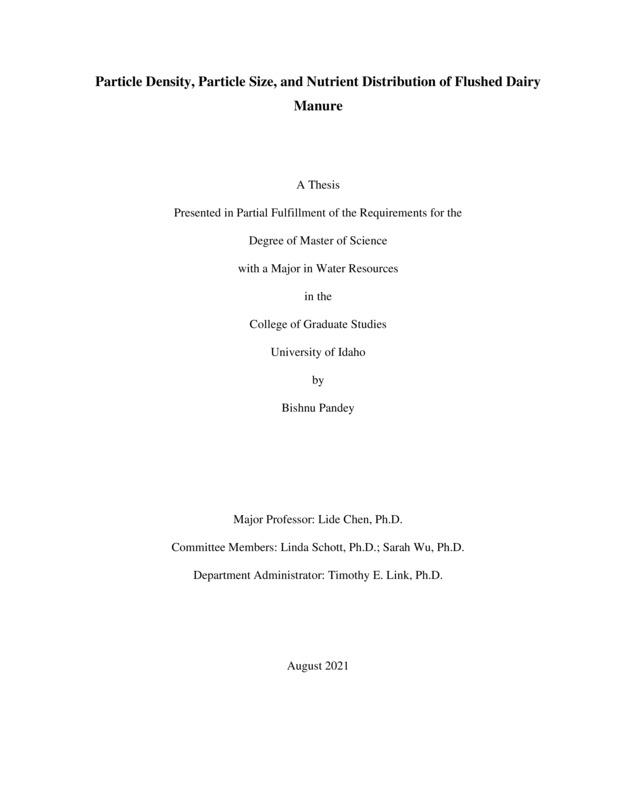Particle Density, Particle Size, and Nutrient Distribution of Flushed Dairy Manure
PANDEY, BISHNU. (2021-08). Particle Density, Particle Size, and Nutrient Distribution of Flushed Dairy Manure. Theses and Dissertations Collection, University of Idaho Library Digital Collections. https://www.lib.uidaho.edu/digital/etd/items/pandey_idaho_0089n_12182.html
- Title:
- Particle Density, Particle Size, and Nutrient Distribution of Flushed Dairy Manure
- Author:
- PANDEY, BISHNU
- ORCID:
- https://orcid.org/0000-0001-5096-0104
- Date:
- 2021-08
- Keywords:
- nutrient distribution flushed dairy manure particle size distribution solid-liquid separation
- Program:
- Water Resources
- Subject Category:
- Water resources management
- Abstract:
-
The handling of large volumes of liquid manure produced by hydraulic flushing systems can be challenging for dairy farmers. The high solid content in flushed dairy manure causes numerous challenges during manure handling, and the high nutrient content limits the amount of manure that can be applied onto cropland. The knowledge of particle density, particle size, and nutrient distribution of flushed dairy manure would allow dairy farmers to select appropriate manure treatment technologies and make better manure nutrient management on their farms. The major goal of this study was to understand the particle density, particle size, and total nitrogen (TN) and total phosphorous (TP) distributions of flushed dairy manure by using four commercial dairies in Southern Idaho as case studies. The study also aimed to examine the statistical significance of using different pore-sized inclined screen separators for solids and nutrients removal from flushed dairy manures of the four dairies. The particle densities of flushed dairy manure solids were determined by the pycnometer method using a methanol medium. A new technique—wet sieving combined with the hydrometer-pipette method—was used to determine the particle size and nutrient distributions of the flushed dairy manures. Nutrient analyses were carried out using the Hach methods: TNT 880 for TN and TNT 845 for TP. The flushed dairy manures of the four dairies differed in the initial total solid as well as nutrient contents with total solids (TS) ranging from 2.23% to 7.69%, TN ranging from 0.08% to 0.19%, and TP ranging from 0.04% to 0.13%. The particle densities of flushed dairy manure solids were found to vary with particle size, and the average particle densities of dried solids in flushed manures of dairies, #1, #2, #3, and #4 were found to be 1.48, 1.39, 1.37, and 1.30 g/cm3, respectively, much lower than the commonly used particle density of soils of 2.65 g/cm3. The distributions of solids and nutrients in flushed dairy manures also varied between the four dairies and were found to be site-specific. However, regardless of the dairy, the majority of TS, TN, and TP in flushed manures were observed at diameters smaller than 0.5 mm. Dairies, #1, #2, #3, and #4 had 63.85%, 58.17%, 57.94%, and 51.50% of TS smaller than 0.5 mm in diameter. Similarly, the percentages of TN and TP observed at diameters smaller than 0.5 mm for dairies, #1, #2, #3, and #4 were 72.00%, 75.14%, 75.76%, and 61.92% and 85.64%, 70.58%, 69.28%, and 61.35%, respectively. The statistical differences between the solid and nutrient removal capacities of different pore-sized inclined screen separators were found to be dairy-specific. From this study, it was estimated that 0.5-mm pore-sized inclined screen separators would remove between 25.41% and 37.40% of TS, 24.24% and 38.08% of TN, and 14.36% and 38.65% of TP from flushed dairy manures with initial TS ranging from 2.23% to 7.69%. This suggests that the inclined screen separators with pore size larger than 0.5 mm would remove only a fraction of total solids, total nitrogen, and total phosphorus from flushed dairy manures, and most of the TS, TN, and TP would remain in the liquid fraction after solid-liquid separation. Therefore, commercial dairies that rely on inclined screen separators with pore sizes larger than 0.5 mm for solid-liquid separation might need to look beyond the 0.5-mm pore-sized screen separators to remove higher quantities of solids and nutrients from their flushed dairy manures.
- Description:
- masters, M.S., Water Resources -- University of Idaho - College of Graduate Studies, 2021-08
- Major Professor:
- Chen, Lide
- Committee:
- Schott, Linda; Wu, Sarah
- Defense Date:
- 2021-08
- Identifier:
- PANDEY_idaho_0089N_12182
- Type:
- Text
- Format Original:
- Format:
- application/pdf
- Rights:
- In Copyright - Educational Use Permitted. For more information, please contact University of Idaho Library Special Collections and Archives Department at libspec@uidaho.edu.
- Standardized Rights:
- http://rightsstatements.org/vocab/InC-EDU/1.0/

